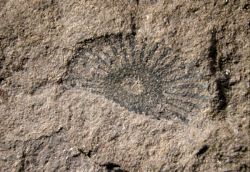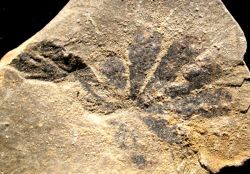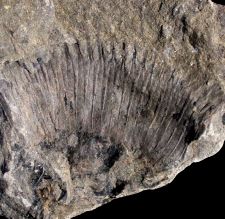Horsetails
Click on the photos for more information.
 A
second species we have found, Equisetum laterale, is much more slender.
The stems have an average diameter of 1.5 cm and the internodes are about
3 cm. Typical for this plant are the diaphragms, which resemble a wheel with
(on average) 32 spokes. We have found some specimens in Cayton Bay.
A
second species we have found, Equisetum laterale, is much more slender.
The stems have an average diameter of 1.5 cm and the internodes are about
3 cm. Typical for this plant are the diaphragms, which resemble a wheel with
(on average) 32 spokes. We have found some specimens in Cayton Bay.
 A very rare find was Annulariopsis simpsonii, also
in Cayton Bay. This plant had leaf whorls reminiscent to those of
Annularia. Annularia however was the foliage of horsetail trees
and those had been extinct for a long time. It is peculiar that only terminal
leaf whorls have been found of Annulariopsis, while most probably
more whorls were present on the stem. Perhaps the part above the whorl was
breaking off very easily when the plant touched the ground. Click
on the photo on the right.
A very rare find was Annulariopsis simpsonii, also
in Cayton Bay. This plant had leaf whorls reminiscent to those of
Annularia. Annularia however was the foliage of horsetail trees
and those had been extinct for a long time. It is peculiar that only terminal
leaf whorls have been found of Annulariopsis, while most probably
more whorls were present on the stem. Perhaps the part above the whorl was
breaking off very easily when the plant touched the ground. Click
on the photo on the right.
